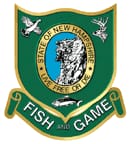Help Stop Aquatic Hitchhikers in New Hampshire
OutdoorHub 07.13.12

As you’re out enjoying recreation on and near New Hampshire’s beautiful waters this summer, do your part to keep “aquatic hitchhikers” like variable milfoil from spreading to and threatening the quality of our lakes, rivers and ponds. The N.H. Fish and Game Department and the N.H. Department of Environmental Services (DES) urge you to check your equipment for milfoil and other nuisance species before you launch. Aquatic nuisance species can easily be transported on boats, motors, trailers, fishing equipment, bait buckets, diving gear and other recreational equipment.
“Aquatic hitchhikers” can sometimes take over lakes and ponds, choking waterways with explosive growth. Once established in a waterbody, aquatic nuisance species are nearly impossible to eradicate.
New Hampshire, with the addition of two recent infested areas, now has a total of 78 infested waterbodies. In most of these, variable milfoil is the primary invasive plant; in others, invasive plants like fanwort, Eurasian water milfoil, water chestnut and Didymo (also known as rock snot, an invasive algae) are becoming established, according to Amy Smagula, DES’s Exotic Species Program Coordinator, who tracks the spread of exotic plants around the Granite State.
“Even just a small piece of the plant, just 2-3 inches in length, is enough to cause a new infestation, so good old-fashioned visual inspection is an important precaution for boaters and anglers,” says Scott Decker, Fisheries Program Supervisor at Fish and Game.
Some 500 “Lake Host” volunteers are stationed at 92 boat launches across New Hampshire lakes to provide a courtesy inspection and educate boaters on how to prevent the spread of exotic species. Working through the New Hampshire Lakes Association, under a grant from DES, these volunteers last year inspected a record-breaking 68,158 courtesy boat and trailer inspections between mid-May and mid-October. A total of 39 exotic species “saves” were recorded on 17 waterbodies, 11 of which are currently free from exotic infestations. This year the program has already documented 36 saves.
“There are not enough Lake Host volunteers to cover all our lakes and rivers, so we rely on boaters and anglers to be responsible and carefully check their own equipment,” says Decker.
One particular invader, Didymo, more commonly known as “rock snot” has now been found in the Connecticut and Mohawk rivers in prime trout fishing areas. It is critical for anglers and paddlers to be aware that Didymo is on the move and is easily spread by even just one microscopic cell of the alga breaking off and drifting downstream in infested reaches. It is also very easily spread by waders, fishing gear and other gear that touches the bottoms of streams in infested areas, so it is essential to check and clean your fishing gear to prevent the spread of Didymo and protect New Hampshire’s waters. Learn more about specific recommended procedures at http://www.wildnh.com/Fishing/Didymo_invasive.html.
STOP AQUATIC HITCHHIKERS! Help protect New Hampshire waters by following these guidelines for preventing the spread of exotic weeds and other aquatic nuisance species:
- LOOK for “Warning Signs” for aquatic nuisance species near boat launch sites.
- HAND-REMOVE all materials (plant or animal) from equipment. Don’t throw the material back into the water! Dispose of it far away from the water. Pay special attention to the bunks or rollers where the boat is seated on the trailer.
- WASH AND DRY all equipment before reuse. Hose off the boat, diving gear or trailer.
- DRAIN AND FLUSH the engine cooling system and live wells of your boat, your bait buckets and the buoyancy control device from diving equipment that’s been in contact with an infested waterbody (to protect against the spread of zebra mussels).
For a list of exotic aquatic plants that are prohibited within New Hampshire, visit the N.H. Department of Environmental Services Exotic Species website at http://des.nh.gov/organization/commissioner/pip/factsheets/bb/documents/bb-40.pdf.
Prevention is New Hampshire’s first line of defense against invasive aquatics. Our second line of defense is early detection and reporting. Through its volunteer Weed Watcher Program, the N.H. Department of Environmental Services takes a proactive approach to exotic plant control by enlisting New Hampshire lake residents, lake associations, anglers and water recreationists to conduct monthly surveys of aquatic vegetation during the growing season. If new infestations are caught early, low-tech methods like hand pulling can sometimes keep them under control and prevent a whole-lake infestation. It is important to note that the areas recently documented as infested did not have a prevention or early detection program in place. To find out more about the Weed Watcher Program and how you can get involved, visit http://des.nh.gov/organization/commissioner/pip/factsheets/bb/documents/bb-4.pdf.
For more information on what you can do to help prevent the spread of invasive aquatic plants and animals, visit http://www.ProtectYourWaters.net/nh. You’ll find the latest news about this problem, detailed procedures to prevent the transport of nuisance species, impacts caused by these species, facts about some of the more common “hitchhikers,” and resources and ideas for you or your club to get involved with prevention efforts.

